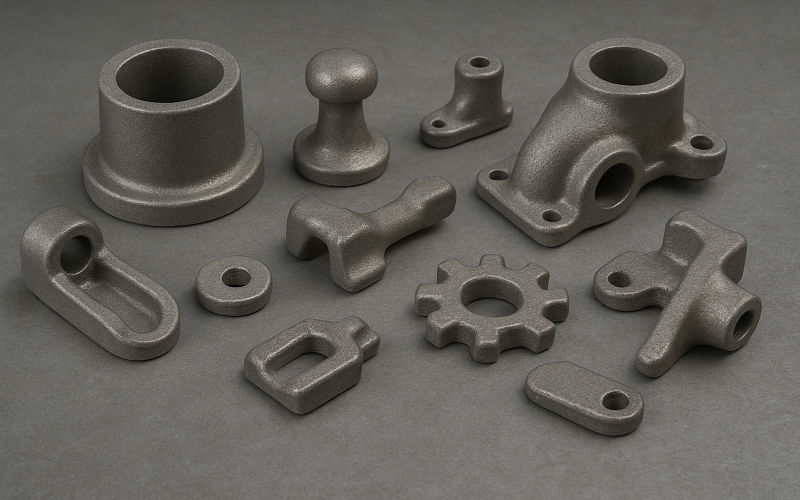Introduction
In the manufacturing world today, precision metal production is no longer a matter of cost and quality it’s a matter of environmental responsibility. As the Indian engineering sector grows, the focus has now shifted to how metal casting operations can minimize their carbon footprints without compromising on high performance parts. In that scenario, the market for investment castings India is fast becoming a case study in transformation demonstrating the way foundries are adopting technology, materials and process innovation to address new sustainability requirements.
The Extent of the Challenge
The Indian foundry industry is a dominant world player manufacturing in the order of 12 million tonnes of castings per year, putting India on the second largest producing nation on earth. In one recent comparison, specific energy consumption for Indian investment casting operations was estimated to be approximately 350 kgoe per tonne far greater than in common grey iron units. This implies that in the wax pattern, ceramic shell, die forged universe of investment castings, raw material and energy intensity are topics of concern.
For investment castings India units, the problem is one of unpinning growth from emissions. A precision alloy and complex geometries and international supply chain foundry needs to deal not only with marketplace needs (lighter, quality) but also with environmental needs (less waste, less emissions).
Major Leverage Points for Carbon Footprint Reduction
Ultimately, precision casting sustainability is based on three broad levers: energy management, materials and waste streams, and process intelligence.
Management of Energy
Melting metal and firing ceramic shells characterize the energy footprint of an investment casting shop. Indian studies of foundry clusters reveal that the replacement of traditional cupola or aged furnace technology with electric induction furnaces can reduce specific energy consumption significantly. Additionally, retrofitting insulation of furnaces, enhancing lid seals, and optimizing operations for off peak tariffs and installing rooftop solar have proved to be extremely cost effective upgrade measures.
Certain Indian foundry units have placed heat-recovery equipment on shell kiln exhaust stacks or dewax oven vents and diverted pre-heated air or scrap heat back into the process. For an Indian precision foundry making investment castings India, using induction melting together with waste heat recovery can lower energy requirements by double digit percentages converting previously a liability to an asset.
Materials and Waste-Flow Optimization
The lost-wax process creates wax patterns, ceramic shell systems, and many times high scrap and reclaim losses. Investment castings India foundries are now utilizing industrial sand reclamation systems, recycling shell sands, changing to low VOC or inorganic binders and recovering wax in dewaxing instead of throwing it away.
For instance, substituting vacuum or microwave dewaxing for solvent based wax removal makes possible wax recovery; recycling such wax decreases virgin wax use and embedded carbon intensity. Likewise, bouncing spent shell sand back into quad-reuse loops or flowing on into second uses decreases solid-waste load.
From a metallurgical point of view, the acceptance of greater scrap metal feed and alloying with recyclability designed alloys assures that the upstream embodied carbon (during mining, transportation etc) is minimized. This is particularly applicable to Indian export oriented shops producing intricate components for aerospace, oil & gas, and energy industries.
Process Intelligence and Lifecycle Mindset
Contemporary Indian investment casting foundries are embracing digital technologies for yield enhancement and defect minimization utilizing simulation, real time monitoring, and data analysis. Reduced defects translate to reduce remits, reduced scrap runs, and less wasted energy and material. Studies in India highlight that tooling optimizations through rapid prototyping for investment castings resulted in environmental risk reductions of as much as 50%.
Moreover, lifecycle-assessment (LCA) thinking is seeping into supplier requirement lists: OEMs abroad now require cradle to gate carbon information from their parts suppliers. Casting units providing investment castings India are reacting by monitoring kWh per tonne, VOC emissions (mg/Nm³), sand-reuse rates, water-reuse volumes and scrap-metal yield in real time. Those metrics facilitate plausible decarburization claims and place the Indian supplier favourable in global supply chains.
Why it Matters for Indian Precision Casting
With increasing international regulation and purchasing pressure on sustainability, having the ability to deliver low carbon credentials provides Indian investment casting plants with a market edge. Numerous international buyers are now demanding supplier disclosures of sustainability preferably casting producers that have demonstrated energy and material-efficient gains, certified environmental-management systems, and showable carbon footprint reduction.
For investment castings Indian companies, the narrative is not merely local cost advantages but access to markets, customer loyalty and reputation power. By saving on energy costs, increasing yield and decreasing waste, these companies are fueling margin enhancement as well as green leadership.
Case Snapshot: Indian Foundry Clusters
A number of India’s foundry clusters, aware of precision casting’s high energy/waste profile, are being targeted for energy efficiency measures. For instance, cluster studies report that traditional cupola furnaces continue to hold sway in some MSME units; but where induction furnaces are utilized and managed, statistics tilt in the positive direction. Pooling of resources e.g., shared waste-heat recovery systems, shared effluent treatment facilities, and solar-farm installations between clusters induces accelerated progress at a fraction of isolated expense.
In investment castings in India, these cluster models work well because several precision foundries operate in SME environments and share infrastructure, labor, and utilities. Joint action introduces cost-saving decarburization at scale.
Accelerating Technologies for Sustainability
India precision casting is being advantageously empowered by a technology integration wave: additive manufacturing (for the creation of wax or pattern), digital twin simulation of solidification, energy input and emissions monitoring based on sensors, and reduced VOC based advanced binder systems. These technologies enable investment castings India companies to bypass incremental change and adopt step-change for sustainability.
Research reviews highlight that rapid tooling and additive routes for investment casting tooling not only slash lead time and cost but also reduce environmental burden significantly. That means less energy, fewer materials, and fewer cycles of trial and error all contributing to lower carbon footprint.
Challenges Ahead
Despite advancements, challenges continue to hinder the Indian precision casting industry. Exorbitant initial capital investment in induction furnaces and WHR systems, dispersed SME ownership, restricted access to green-finance, non-uniform adoption of monitoring and reporting systems and regulatory gaps all hinder the rate of change. Also, precise measurement of carbon footprint for a single casting part is a challenging exercise involving expertise and data.
For investment castings players in India, closing these gaps entails partnering with green loan offering financial institutions, tapping government incentive schemes, being part of cluster level common assets and engaging in open sustainability reporting.
Foundry Strategic Roadmap
A doable roadmap for casting houses producing precision components entails:
- Carrying out a base energy and material audit (kWh/tonne, scrap %, sand reuse %, VOC emissions).
- Prioritizing high impact interventions: e.g., furnace change, rooftop solar installation, adding sand reclamation.
- Applying digital monitoring to monitor gains; establishing ISO 14001 or ISO 50001 systems for assuring governance.
- Estimating and releasing a carbon intensity figure for a representative component (e.g., kg CO₂ equivalent per kg of cast component).
- Working with customers to build sustainability credentials particularly in export markets.
- Cluster based collaboration between foundries for common infrastructure and tapping into subsidized schemes for MSMEs.
For companies undertaking investment castings manufacturers, incorporating sustainability isn’t an environmental appendage it becomes highly strategic.
The Business and Environmental Benefit
Effectively practiced sustainability delivers various pay offs: reduced energy costs, increased yield, less defects, enhanced brand reputation, improved export market access, and compliance with regulations. In one sector, a foundry implementing induction melting, rooftop solar and sand reclamation achieved double-digit percentage energy consumption reduction within twelve months.
Also, as world supply chains put greater emphasis on carbon reporting and green manufacturing, Indian precision casting companies that exhibit sustainability can have higher value assigned by clients, get access to green financing, and gain resilience to future regulatory changes.
Conclusion
The world of precision metal production in India is changing. For the investment castings Indiaspace, the call is clear: decarbonize while growing. Energy efficient furnaces, sand/metal recycling cycles, electronic controls, and lifecycle metering and cluster cooperation are now the main pillars of competitiveness. Foundries that make these changes with seriousness reap far more than cost reductions credibility, access and preparedness that global markets increasingly require. In the broader sweep of industrial development, Indian precision casting plants are not mere passive players they are aggressively shaping a clean future in metal production.



